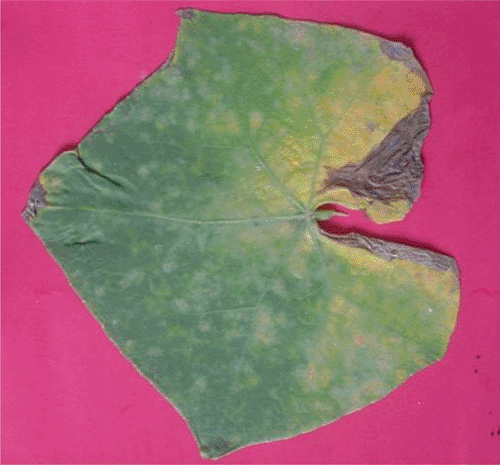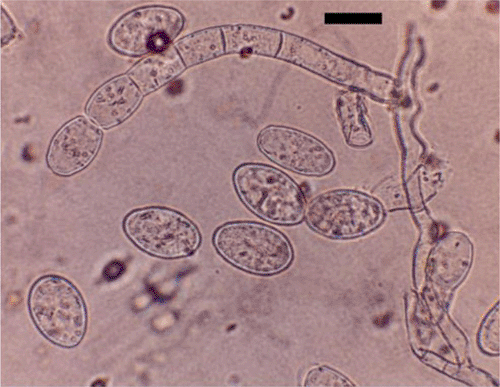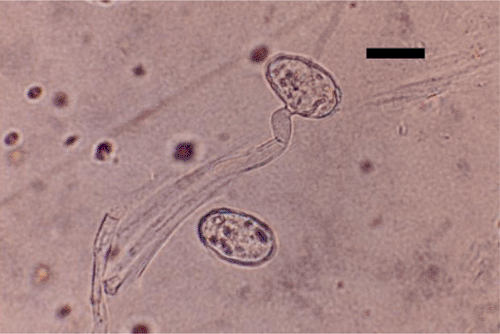Powdery mildew on Sechium edule in India
P. Baiswar A B , S. Chandra A and S. V. Ngachan AA ICAR Research Complex for NEH Region, Umiam, Meghalaya 793103, India.
B Corresponding author. Email: pbaiswar@yahoo.com
Australasian Plant Disease Notes 3(1) 160-161 https://doi.org/10.1071/DN08062
Submitted: 13 August 2008 Accepted: 9 November 2008 Published: 27 November 2008
Abstract
Tribal communities in north-east India commonly grow Sechium edule for its edible immature fruits, starchy roots, tender shoots and leaves. Severe powdery mildew symptoms were observed on the leaves of S. edule. Based on the morphological characters the pathogen was identified as an anamorph of Podosphaera xanthii. This is the first report of this organism causing powdery mildew on S. edule in Meghalaya, India.
Sechium edule popularly known as Chow-chow is a perennial plant, native to tropical America. It is grown in the hills of Meghalaya, Manipur, Mizoram, Nagaland, Sikkim and West Bengal in India (Rai et al. 2002). Tribals cultivate this crop for its edible immature fruits and large starchy roots (Yadav et al. 2005). Young shoots and tender leaves are also used as vegetables. It is often used in place of potato.
Leaves of S. edule showing powdery mildew symptoms were collected during June 2008 from Barapani, Meghalaya (north-east India). Symptoms included grayish white powdery growth consisting of epiphytic mycelia and conidia mostly on upper surface of the leaves (Fig. 1). Symptoms on the lower surface were less conspicuous and on the corresponding upper surface yellow spots were present. Older leaves were found to be more susceptible. Defoliation was observed in severely infected plants. A voucher specimen has been deposited in IMI Herbarium, CABI, UK (IMI 396734).

|
Hyphae were to 6–9 μm wide (widest at the point of origin of conidiophores) with indistinct appressoria. Conidia were harvested by dislodging them from infected tissue onto a strip of clear tape, using a camelhair brush. The tapes were mounted on microscopic slides (Correll et al. 1987). Conidiophores were straight and unbranched comprising cylindrical foot cells (40–58 × 8–11 μm) followed by few smaller and slightly narrower cells; conidia were ellipsoidal in shape (26–38 × 16–19 μm) and produced in chain. Basal septa of conidiophores were adjacent to mycelium (Fig. 2). Fibrosin bodies were present. Germtubes developed laterally with simple appressoria (Fig. 3). No perfect stage was found to be associated with this fungus. Heavy parasitisation by Ampelomyces quisqualis was also observed. Pycnidia were formed on conidiophores of the powdery mildew pathogen. Pathogenicity was confirmed by dusting conidia onto healthy plants of S. edule; non-inoculated plants served as controls. Inoculated leaves developed symptoms after 7–8 days, whereas control plants remained healthy.

|

|
Golovinomyces cichoracearum (Piepenbring 2006), Erysiphe sp. (Alvarez 1976), Podosphaera xanthii (Amano 1986), P. fusca (Braun 1995) and P. humuli (Farr et al. 2005) have been reported on S. edule. From India powdery mildew caused by Oidium sp. has been reported without any description on this host (Mathur 1979). In our case the presence of fibrosin bodies and indistinct appressoria ruled out the possibility of G. cichoracearum and Erysiphe sp. Based on these observations the organism was identified as an anamorph of Podosphaera xanthii (Braun et al. 2001). P. fusca has previously been used in a broader sense to include P. xanthii and P. humuli. The name P. humuli appears to be mistakenly applied to powdery mildew since this pathogen has high host specificity towards genus Humulus (U. Braun, pers. comm.).
To our knowledge, this is the first record of powdery mildew caused by anamorph of P. xanthii on S. edule in India. This is normally considered as a hardy and pest free crop. Until now only one disease, leaf spot caused by Cercospora citrullina has been reported on this species from India (Lucy Channamma and Rangaswami 1968). This disease is of concern to the tribal population of north-east India since this crop is grown for vegetable purposes and powdery mildew is particularly destructive in this region.
Alvarez MG
(1976) Primer catalogo de enfermedades de plantas Mexicanas. Fitofilo 71, 1–169.
[Verified 11 November 2008]
Lucy Channamma KA, Rangaswami G
(1968) On the occurrence of two new Cercospora leaf spots in India. Indian Phytopathology 22, 143–145.

Piepenbring M
(2006) Checklist of fungi in Panama. Puente Biology 1, 1–190.

Rai N,
Yadav DS,
Nath A, Yadav RK
(2002) Chow-Chow – A poor man vegetable for northeastern hill region. Indian Farming 10, 18–19.

Yadav RK,
Yadav DS, Sarma P
(2005) Diversity of cucurbitaceous crops in northeastern region. ENVIS Bulletin: Himalayan Ecology 13, 15–25.



